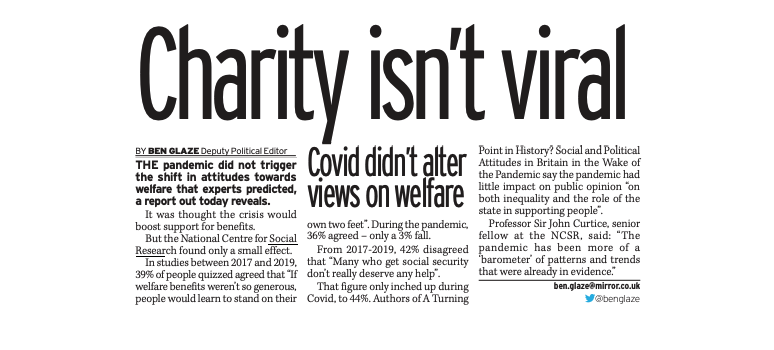
Dominic Abrams, along with John Curtice, and Curtis Jessop, co author this blog about the findings in their recent paper, examining the extent to which the pandemic has changed societal views.
During the course of the COVID-19 pandemic, there has been much discussion about what its long-term legacy would be. In particular, it has often been suggested it could represent a ‘reset’ moment – or a ‘turning point in history’ – that instigates a radical change in how society is organised and what governments do.
But have the public changed their views about the kind of country they would like to live in? After all, policy makers are likely to find it difficult to instigate significant social and economic change unless the public themselves have come to the conclusion that change is necessary.
Today we issue a report on how public attitudes have evolved in the wake of the pandemic. Following on from previous analyses (reported here (pdf) and also reported here), it examines the extent to which the balance of opinion towards (1) inequality, welfare and the role of the state, and (2) law conformity and trust, has changed in the wake of the pandemic. It is based on the results of two special surveys conducted in summer 2020 and summer 2021 via NatCen’s mixed-mode random probability panel and the results of the 2020 British Social Attitudes survey conducted in the autumn of that year. To ascertain the impact of the pandemic, the results are compared with readings obtained by the British Social Attitudes survey over the last 30 years.
Public attitudes have changed in some important respects in recent years – but these changes were already in evidence before the pandemic started. During the pandemic itself, the trends have either continued further or at least not been reversed. There is, however, little evidence that the pandemic has seen public attitudes shift in a markedly different direction.
One key trend that was in evidence before the pandemic was the advent of a more sympathetic attitude towards welfare for those of working age.
For example, on average between 2007 and 2015, just over half (53%) agreed with the statement that ‘if welfare benefits weren’t so generous, people would learn to stand on their own two feet’. However, between 2017 and 2019 this figure had already dropped to 39%. Now, in our three pandemic surveys it has stood at 36%, little different from immediately beforehand.
A similar pattern is also in evidence in attitudes towards the unemployed. Between 2002 and 2012, on average only 27% disagreed that ‘most people on the dole are fiddling one way or another’. However, between 2017 and 2019 the figure had increased to 39%, and, at 40%, it was little different across our three pandemic surveys.
The pandemic occurred at a time when public attitudes towards welfare and the unemployed had already shifted. That change of mood that may well have helped ensure public approval for the government’s attempt to limit unemployment via its ‘furlough’ scheme and the £20 a week uplift in the rate of Universal Credit. But it is not clear that the pandemic itself has changed the public mood.
More people do favour than oppose achieving one of the potential aims of any welfare system – reducing inequality. For example, 43% agreed in our three pandemic surveys that ‘government should redistribute income from the better-off to the less well-off’ whereas only 30% disagreed. However, there is little sign of any meaningful shift from the 41% who expressed agreement between 2017 and 2019.
A second trend in public attitudes that has been in evidence in recent years has been a somewhat liberal outlook towards the law and towards the need for people to conform to social norms and respect ‘traditional values’. However, that trend was potentially put to the test in the pandemic when a ‘fear of contagion’ might have made people feel that everyone should be respecting the rules designed to protect public health.
Between 1998 and 2014, on average 80% said they agreed with the statement, ‘people who break the law should be given stiffer sentences’. But by 2018 and 2019 that proportion had fallen to two-thirds (67%). That shift has, if anything, continued further during the pandemic, with those agreeing slipping further to 62% in our most recent survey.
Similarly, between 1999 and 2014, on average 71% agreed that ‘young people today don’t have enough respect for traditional British values’. But between 2017 and 2019 those expressing that view had fallen to 58%, and slipped further to 54% across our three pandemic surveys.
However, this apparent further trend towards a more liberal outlook was not in evidence on some specific subjects.
In the two surveys conducted via the NatCen Panel, 27% said that protest matches and demonstrations against a government action should ‘definitely’ or ‘probably’ not be allowed, up from 20% when the question was previously asked in 2016. Meanwhile, there was also a slight drop – from 67% between 2017 and 2019 to 63% on our two panel surveys – in the proportion who said that ‘sexual relations between two adults of the same sex’ are ‘not all wrong’.
In short, our evidence has uncovered little sign that the pandemic has proven to be a ‘turning point’ in public opinion. Some of the debates that arose during lockdown about the provision of welfare and the role of the law were more of a reflection of attitudes that had already been changing rather than an indication of a new-found concern. The pandemic may, perhaps surprisingly, have been more of a ‘barometer’ than a ‘turning point’, telling us more about the kind of country that Britain had already become rather than proving to be an event that fundamentally changed the landscape of public opinion.
This blog was authored by John Curtice, Dominic Abrams and Curtis Jessop and originally appeared on the NatCen blog page.





